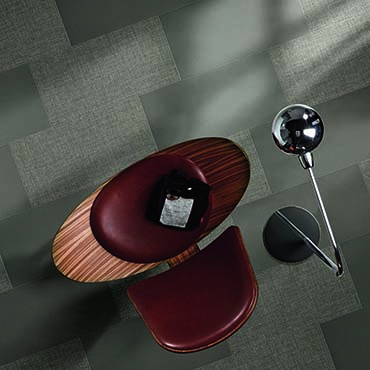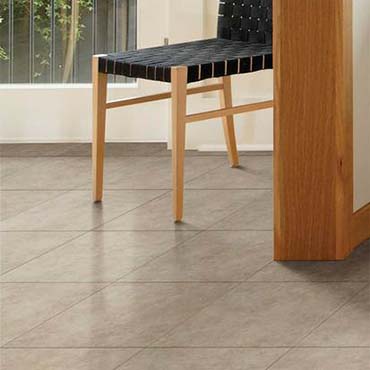Transform any room with DalTile® Floor Tile. Available in porcelain, ceramic, and stone looks, DalTile offers durable, stylish, and easy-to-maintain flooring options perfect for kitchens, bathrooms, living areas, and high-traffic commercial spaces. Learn More
Mosaic Tile
Mosaic Tile Guide

Mosaic Tile Flooring: A Timeless Fusion of Durability and Design Aesthetics
Introduction:
Mosaic tile flooring, a storied art form, has transcended centuries, evolving from simple stone arrangements in ancient civilizations to sophisticated elements in modern architectural landscapes. Once a symbol of opulence in Roman and Byzantine empires, today it marries historical significance with contemporary design trends, offering unparalleled versatility and technical prowess.
Defining Mosaic in Modern Floor Tile:
Mosaic tile flooring comprises numerous small pieces of tile - typically made of glass, stone, or ceramics - arranged to create intricate patterns and images. This art form, now revitalized with modern materials and techniques, has become a staple in architectural and interior design, offering unique expressions in both residential and commercial spaces.
Material Properties and Sustainability:
Mosaic tiles are celebrated for their durability and resistance to wear and tear, making them ideal for high-traffic areas. Their low maintenance requirements, coupled with their longevity, position them as a sustainable flooring option. Modern production techniques have further enhanced these aspects, with many manufacturers embracing energy-efficient processes and recyclability of materials, aligning with the growing demand for eco-friendly building materials.
Design Versatility and Aesthetics:
The design potential of mosaic tile flooring is vast, with an array of colors, patterns, sizes, and finishes. This versatility allows architects and designers to tailor designs to specific architectural styles, enabling the creation of unique and personalized spaces. From minimalist patterns to elaborate artistic murals, mosaic tiles can complement or become the centerpiece of any design scheme.
Technical Advancements:
Technological innovations in manufacturing have revolutionized the mosaic tile industry. Digital printing and cutting technologies allow for precise and intricate designs, expanding customizability and creative possibilities. These advancements have made mosaic tiles more accessible and adaptable, catering to a broader range of design requirements.
Application Diversity:
Mosaic tile flooring's application ranges from luxurious hotel lobbies to practical solutions in healthcare facilities. Innovative uses in recent projects demonstrate its adaptability - from creating visual narratives in public spaces to enhancing the aesthetic appeal of residential interiors. The blend of functionality and artistry makes mosaic tiles a preferred choice among architects and designers.
Performance and Functionality:
Beyond their visual appeal, mosaic tiles offer functional benefits. Their water resistance and antibacterial properties make them ideal for spaces demanding hygiene and easy maintenance, such as kitchens, bathrooms, and healthcare facilities. Additionally, their suitability for high-traffic areas attests to their durability and long-term performance.
Sustainability and Environmental Impact:
Mosaic tiles contribute significantly to sustainable building practices. Many mosaic products are now designed to meet LEED certification and other environmental standards, focusing on reduced environmental impact and improved indoor air quality. The production and usage of these tiles are increasingly aligned with eco-friendly building specifications, underlining their role in sustainable architecture.
Cultural and Artistic Significance:
Mosaic tile flooring holds immense cultural and artistic value. Contemporary designers are blending this traditional art form with modern design principles, creating spaces that narrate stories and preserve cultural heritage while embracing modern aesthetics.
Cost-Effectiveness and Long-Term Value:
While initial costs may be higher compared to some flooring options, mosaic tiles offer long-term value. Their durability and timeless appeal often outweigh the initial investment, especially when compared to materials that require frequent replacement or maintenance.
Conclusion:
Mosaic tile flooring stands at the intersection of durability, design versatility, and sustainability. As we look towards future architectural and interior design trends, these tiles offer a unique blend of aesthetic appeal and functional excellence. For architects, interior designers, and facility managers, the innovative potential of mosaic tile flooring is an avenue worth exploring, promising to enrich spaces with both beauty and practicality.
Disclaimer: The information provided in this article is for general informational purposes only. While we strive to ensure the accuracy and reliability of the information presented, we make no warranties, express or implied, about the completeness, accuracy, reliability, suitability, or availability with respect to the content. Any reliance you place on such information is strictly at your own risk. We recommend consulting with professionals for specific advice tailored to your project’s needs, particularly regarding building codes, regulations, and product specifications.
Under no circumstances shall we be liable for any loss or damage, including without limitation, indirect or consequential loss or damage, arising from the use of, or reliance on, the information provided in this article.
Select Product Sub-Category:
Mosaic Tile
Top 3 Types of Mosaic Tile
 Ceramic/Porcelain - 248 Mosaic Tile (glass)Introducing our exquisite Glass Mosaic Tiles! Elevate your space with stunning, shimmering designs. Create artistry in every room. Order now and transform your home today! | |
 Ceramic/Porcelain - 86 Mosaic Tile (glazed)Transform your living space with our Glazed Mosaic Tiles! These stunning tiles add a touch of artistry to any room. Create a mosaic masterpiece today! | |
 Ceramic/Porcelain - 489 Mosaic Tile (unglazed)Introducing our unglazed Mosaic Tile: A raw canvas for your creative vision. Craft stunning designs with this versatile tile. Get started today! |
Featured Brands
The Best 5 Mosaic Tile Brands

Daltile® Floor Tile
Profile | Website | Install | MaintainTransform any room with DalTile® Floor Tile. Available in porcelain, ceramic, and stone looks, DalTile offers durable, stylish, and easy-to-maintain flooring options perfect for kitchens, bathrooms, living areas, and high-traffic commercial spaces. Learn More

American Olean® Tile
Profile | Website | Warranty | GreenHome is where the heart is, and American Olean is the trusted choice for residential projects. With countless, on-trend design options, the versatility and durability of American Olean tile make it easy to produce stylish, modern designs anywhere in your home. Learn More

Emser® Floor Tile
Profile | WebsiteEMSER is the fashion leader in ceramic tile and natural stone. We are committed to providing the service and selection today’s marketplace demands. EMSER’S products are specified and installed in malls, hotels, educational facilities and other major projects throughout the United States. Learn More

Vitromex® Tile
Profile | WebsiteVitromex® is a mexican company that belongs to the Grupo Industrial Saltillo. Since its foundation in 1967 we manufacture ceramic coverings for floor tiles and wall tiles, as well as sanitary-ware with the highest quality standards. Learn More

Mid-America Tile
Profile | WebsiteEstablished in 1961, Mid America Tile is a wholesale tile distributor and importer specializing in all materials and styles, including ceramic, porcelain, glass, metal, and natural stone tile. Learn More
Mosaic Tile News
Latest Mosaic Tile News
Multiplier Mosaic Tile Collection...Crossville, Inc. recently launched the Multiplier mosaic tile collection. This versatile mosaic tile collection provides traditional sizes and colors for easy floor and wall installations at a value price. With three essential colors and three fun shapes, the Multiplier collection expands design possibilities for commercial and residential spaces. “Whether a designer wants to incorporat... |
DEFEND™ Powered by MICROBAN®...PROTECT AGAINST THE INVISIBLE DEFEND™ powered by Microban® is a distinct product line of high-performance porcelain antimicrobial floor, wall and mosaic tiles, continuously fighting the growth of up to 99% of bacteria on the surface. The DEFEND products were designed to promote cleaner spaces empowered with Microban® antimicrobial product protection and to provide a lifetime of cleanlin... |
Mythique Marble...Mythique Marble is a porcelain floor, ceramic wall, and mosaic tile collection offering four on-trend marble designs, each equally elegant yet unique. All Mythique Marble products feature Microban technology that provides robust antimicrobial product protection. The inclusion of Microban technology equips this product line to stand up to daily life demands while delivering an abundance... |
3 Glass Tile Bathroom Design Concepts Inspired By Summer...the Blue Blue is always a great choice for beach bathroom decor. Whether you’re creating a navy and white striped nautical theme or replicating flowing water with lighter blues, blue mosaic tile can create the look you want. To create stunning backsplashes or shower surrounds, use Color Appeal's Pacific Coast Blend, which combines moonlight blue and pearl-colored glass til... |
4 Tips for Using Tile Sizes to Your Advantage...all Rooms Flow Tiny tiles can help improve the flow of small floor plans when the spacing between the sink, toilet, cabinets, and other bathroom fixtures is compact. Small tiles like mosaic tiles require fewer cuts, which ultimately offers a more streamlined look. 3. Plank Tiles Add Depth and Texture When you want the warmth and coziness of hardwoo... |
Mosaic Tile...Mosaic Magic: Transforming Spaces with Timeless Tiles Introduction to Mosaic TileMosaic tiles, with their rich historical tapestry, have evolved from simple earthen floors to ornate design elements. Originating in Mesopotamia, these tiny, durable pieces have graced spaces from ancient Greek homes to modern high-rises, showcasing an unending allure in home decorat... |
Porcelain Tile Flooring...ntial property showcased the versatility of porcelain tiles beautifully. In the living area, large-format, marble-look tiles provided a luxurious yet durable flooring solution, while in the bathroom, mosaic tiles in a herringbone pattern added depth and interest. This project highlighted how porcelain tiles can be used to achieve both aesthetic elegance and practical robustness. Conclu... |
Mosaic Tile (glazed)...Glazed Mosaic Tile: A Timeless Choice for Modern Design In the realm of interior design, materials often come and go, but some, like glazed mosaic tile, stand the test of time. From their humble beginnings as functional elements in ancient Mesopotamian temples to becoming a staple in contemporary design, glazed mosaic tiles have evolved significantly. Today, they are not just a... |
Bathroom Tile...led design flexibility. For traditional designs, classic patterns and neutral tones create a timeless look. Contemporary spaces might feature bold colors, large-format tiles, or minimalistic designs. Mosaic tiles can introduce texture and color, adding personality to any bathroom. Intricate patterns, like herringbone or chevron, can transform a space, making it visually captivating. Pr... |
Mosaic Tile (glass)...The Timeless Charm of Glass Mosaic Tile in Modern Interior Design In the realm of interior design, the allure of glass mosaic tiles is both timeless and ever-evolving. These tiles, with their roots in ancient art, have traversed centuries, transforming from mere functional elements to pivotal design features in contemporary homes. This 750-word exploration delves into the world... |
Mosaic Tile (unglazed)...Timeless Charm and Modern Elegance: The Renaissance of Unglazed Mosaic Tiles in Interior Design The Evolution of a Classic: A Brief History of Unglazed Mosaic TileUnglazed mosaic tiles, with their roots in ancient civilizations, have journeyed through time, evolving from mere functional elements to key features in interior design. These small, sturdy pieces, ofte... |




